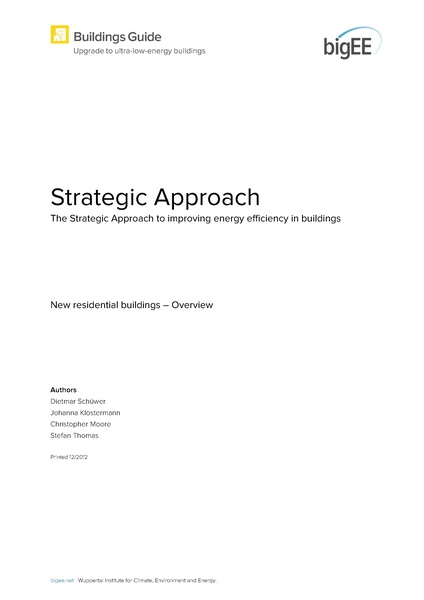File:Bigee txt 0043 bg strategic approach overview new residential.pdf
 Size of this JPG preview of this PDF file: 424 × 600 pixels. Other resolution: 169 × 240 pixels. |
Original file (2,479 × 3,508 pixels, file size: 386 KB, MIME type: application/pdf, 10 pages)
Summary
The Strategic Approach follows a holistic design process with the premise of first implementing passive options for building design and then implementing the active options as need arises to provide thermal comfort. These systems then need to be controlled intelligently through automation and informed user behaviour to reach maximum optimization. In the short-term, the Easy-Efficiency Approach should be implemented at minimum. It focuses on low-cost options, mainly passive options. Improving energy efficiency by implementing the Easy-Efficiency Approach can reduce primary energy consumption for cooling, heating, ventilation and domestic hot water by 40 to 60 % to achieve a Low-Energy Building (LEB). Implementing the advanced approach can reduce primary energy consumption by up to 90 % to achieve an Ultra-Low- Energy Building (ULEB). Further improvements, especially through the use of renewable energy technologies can reduce the primary energy consumption by nearly 100 % or even beyond achieving (nearly) Zero-Energy Buildings (nZEB) to being net energy producer Plus-Energy Buildings (PEB).
Licensing
| File from an External Source | This file is from an external source. The copyright provisions of the original source apply to this file. Please report copyright infringements to the energypedia team so that it can delete the appropriate files. |
|---|
File history
Click on a date/time to view the file as it appeared at that time.
| Date/Time | Thumbnail | Dimensions | User | Comment | |
|---|---|---|---|---|---|
| current | 21:00, 15 December 2014 |  | 2,479 × 3,508, 10 pages (386 KB) | ***** (***** | *****) | The Strategic Approach follows a holistic design process with the premise of first implementing passive options for building design and then implementing the active options as need arises to provide thermal comfort. These systems then need to be contro... |
You cannot overwrite this file.
File usage
There are no pages that use this file.




















